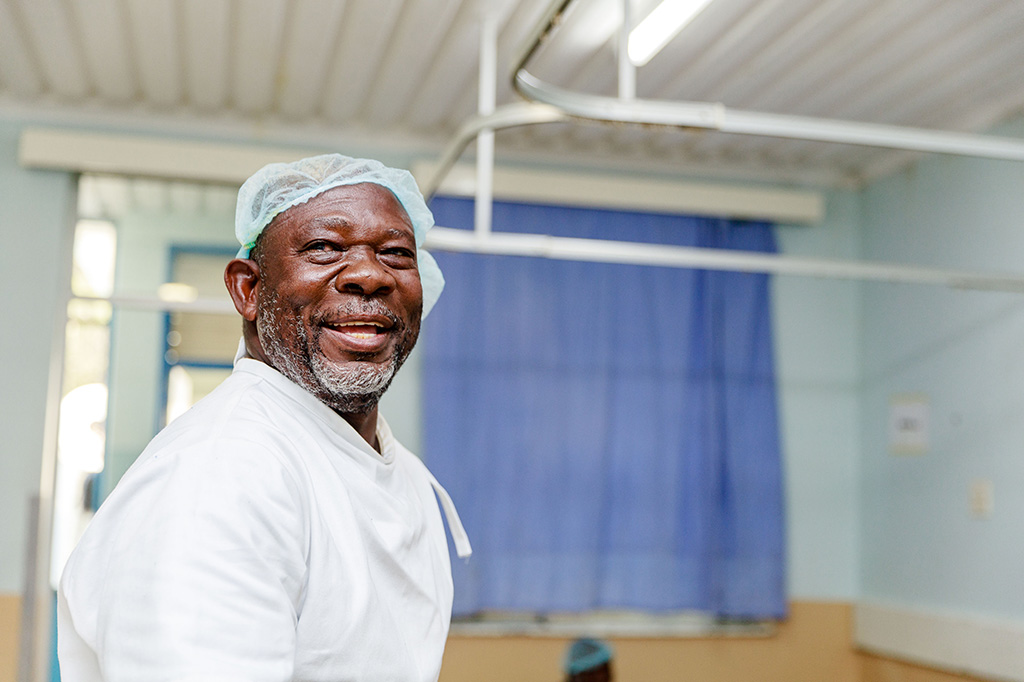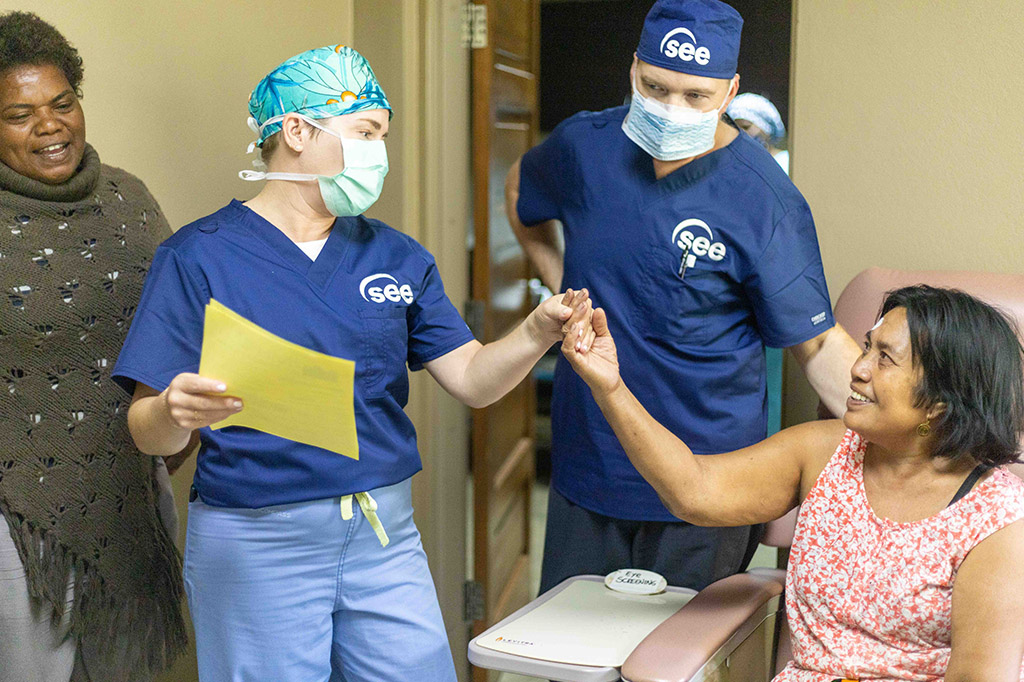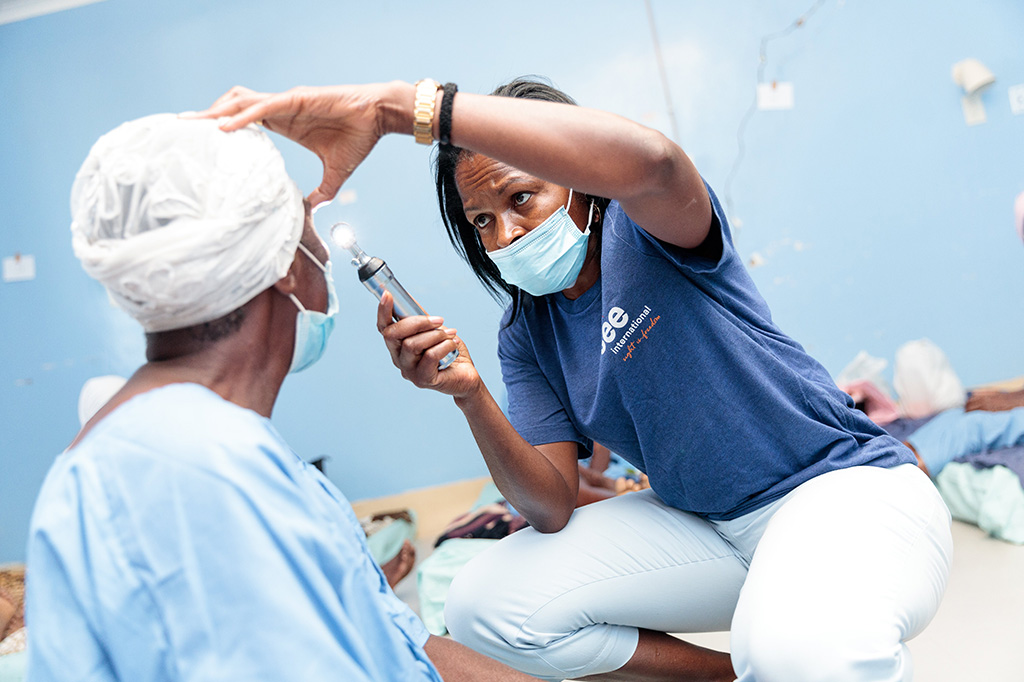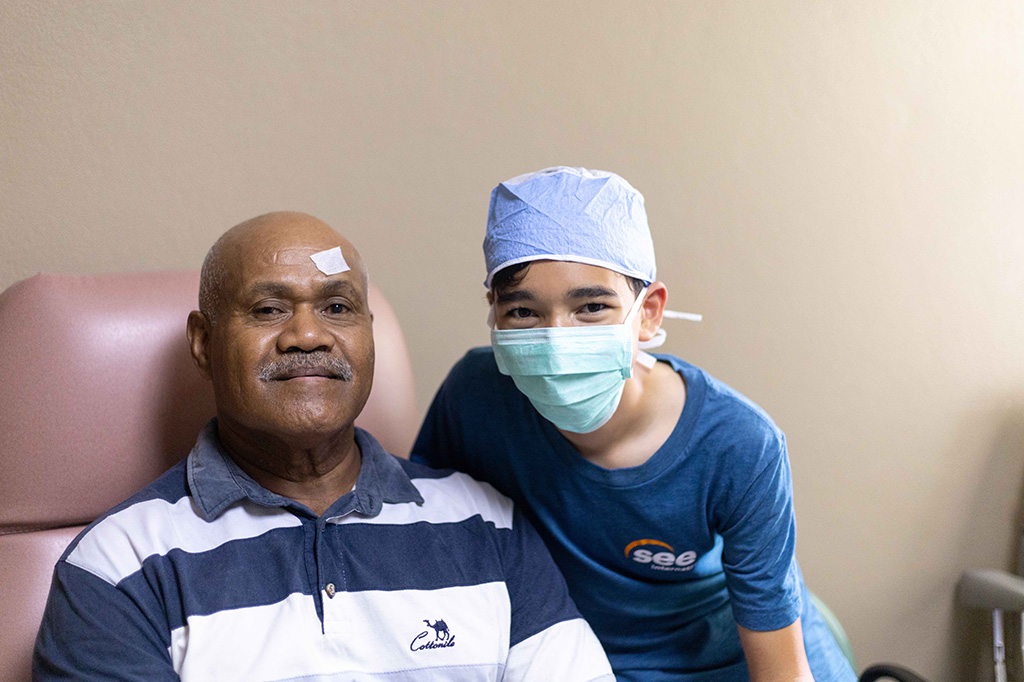Diabetic Retinopathy
Since 1974, SEE has worked diligently around the world to reduce the number of people impacted by diabetic retinopathy. Our network of volunteer surgeons provide free treatment to thousands of patients every year, as well as skill-sharing and training on appropriate surgical techniques to help strengthen local health care infrastructure worldwide.
What is Diabetic Retinopathy?
Diabetic retinopathy (DR) is a complication of diabetes caused by damage to blood vessels in the eyes.
Diabetic retinopathy is an eye condition that can cause vision loss and blindness in people who have diabetes. It affects blood vessels in the retina (the light-sensitive layer of tissue in the back of the eye).
(Source: National Eye Institute, 2022)

What are symptoms of Diabetic retinopathy?
The early stages of diabetic retinopathy usually doesn’t present any symptoms. Some people notice changes in their vision, like trouble reading or seeing faraway objects. These changes may come and go.
In later stages of the disease, blood vessels in the retina start to bleed into the vitreous (the gel-like fluid that fills the eye). If this happens, you may see dark, floating spots or streaks that look like cobwebs. Sometimes, the spots clear up on their own, but without treatment scars can form in the back of the eye. Blood vessels may start to bleed again, or the bleeding may get worse.
(Source: National Eye Institute, 2022)
There aren’t usually any early warning signs or symptoms of DR.
In advanced cases of diabetic retinopathy, symptoms occur when the retina, located in the back of the eye, develops abnormal new blood vessels that are weak and prone to bleeding. As more blood leaks out of the vessels over time, vision becomes increasingly obstructed.
Effects of Diabetic Retinopathy
Diabetic retinopathy can lead to other serious eye conditions:
- Diabetic macular edema (DME). Over time, about 1 in 15 people with diabetes will develop DME. DME happens when blood vessels in the retina leak fluid into the macula (a part of the retina needed for sharp, central vision). This causes blurry vision.
- Neovascular glaucoma. Diabetic retinopathy can cause abnormal blood vessels to grow out of the retina and block fluid from draining out of the eye. This causes a type of glaucoma (a group of eye diseases that can cause vision loss and blindness).
- Retinal detachment. Diabetic retinopathy can cause scars to form in the back of the eye. When the scars pull the retina away from the back of the eye, it’s called tractional retinal detachment.
(Source: National Eye Institute, 2022)
When vision loss occurs, it is often too late to fully restore sight, making it crucial for people with diabetes to get eye exams at least once a year. If left untreated, some patients may only be able to see the difference between light and dark, and nothing more. In severe cases, the condition may even cause the retina to detach, thus requiring surgery to mend.

Around 3 million affected individuals
An estimated 3 million individuals worldwide suffer from diabetic retinopathy today, accounting for 0.36% of blindness worldwide. According to the World Health Organization, diabetes is the leading cause of new cases of blindness among adults aged 20-74 years. Currently, more than 422 million people worldwide have diabetes, and this number is projected to skyrocket in the next decade. Approximately half of these cases are likely to develop DR. Rates of both diabetes and DR are expected to increase significantly in developing countries due to a lack of access to health care.
There are approximately 93 million people with diabetic retinopathy. Longer diabetes duration and poorer glycemic and blood pressure control are strongly associated with diabetic retinopathy.
(Source: Yau et al, 2012)
Your donation will save someone’s sight
Risk Factors
Anyone with any kind of diabetes can get diabetic retinopathy — including people with type 1, type 2, and gestational diabetes (a type of diabetes that can develop during pregnancy).
Risk increases the longer one has diabetes. Over time, more than half of people with diabetes will develop diabetic retinopathy. The good news is that managing diabetes well significantly lowers the risk.
(Source: National Eye Institute, 2022)
Factors that may increase the chance of someone with diabetes developing DR include the following:
- How long the patient has had diabetes
- How well the patient maintains his or her blood sugar level
- High blood pressure
- High cholesterol
- Pregnancy
- Tobacco use
Prevention
Managing your diabetes is the best way to lower your risk of diabetic retinopathy. That means keeping your blood sugar levels in a healthy range. You can do this by getting regular physical activity, eating healthy, and carefully following your doctor’s instructions for your insulin or other diabetes medicines.
Having high blood pressure or high cholesterol along with diabetes increases your risk for diabetic retinopathy. Controlling blood pressure and cholesterol can help lower risk for vision loss.
(Source: National Eye Institute, 2022)
Development of diabetic retinopathy can be prevented or slowed through the careful management of one’s diabetes, which includes the following:
- Getting annual eye screenings, which can detect diabetic retinopathy in its early stages
- Regular injections as treatment
- Meticulously regulating one’s blood sugar
- Keeping an eye on cholesterol and blood pressure
- Avoiding tobacco use

Treating Diabetic Retinopathy
SEE’s preferred method of treatment is called Pan-Retinal Photocoagulation, or PRP for short. This technique employs a laser to stop neovascularization (the growth of new abnormal blood vessels due to diabetes). This is a less invasive treatment than surgery and is less expensive than retinal drug injections. However, it may require follow-up treatments, depending on the severity of neovascularization and how well the patient has cared for his or her diabetes.
(Source: Weng et al, 2022)
SEE International & Diabetic Retinopathy
Here are some of the initiatives SEE is taking to end DR worldwide:
- Training local eye care personnel in how to accurately diagnose DR and appropriate treatment techniques.
- Working with local organizations to increase awareness and prevention of diabetes and DR.
- Strengthening local health care infrastructure.
Launching a DR Initiative in 2011 with long-term partners in Honduras, Peru, Vietnam, Georgia, India, and Ghana. SEE works with these sites to build capacity by placing donated DR equipment on permanent loan and by visiting the clinics on a regular basis. SEE volunteers help address the backlog of patients and train the local ophthalmologists in how to identify and treat the disease on their own. During the first two years of the program, doctors performed more than 1,000 DR screenings and 32 laser treatments.
Learn more about diabetic retinopathy

Conditions We Treat
Get Our Monthly Updates
Connect With SEE
Learn More
Donate
(805) 380-7522
Mail donations to:
SEE International
PO Box 981263
W. Sacramento, CA 95798-1263
Home office address:
6500 Hollister, Suite 120
Goleta, CA 93117
Tax ID: #31-1682275


